Get ready for a shocker, ladies and gentlemen! If you think that “wearable mobile technology” is the newest new thing (ie. the Apple Watch/Smart Phone/Monitor, etc.), the fact is that it was all quite self-evident back in the late 1960’s to America’s most beloved secret agent, Maxwell Smart[1]. As a memory aid for baby boomers… and as a socio-cultural primer for those born after 1980… Max Smart was the key linchpin in the ongoing efforts by the free world agency, “CONTROL”, to stymie the dark forces of oppression (“KAOS”) in its mission to maximize mischief and mayhem in the U.S.
In case a few of our “Boomers” have forgotten how visionary Max was… just access the following link, scroll down to the bottom of the content area, and watch the streaming video in which Maxwell Smart demonstrates multiple forms of “wearable wireless technology” four and a half decades before Apple managed to manufacture it!!
At this point you must be wondering if I have fallen under the influence of mushrooms straight out of Alice in Wonderland: “What has gotten into Petty and why is he babbling on about Maxwell Smart?”
The reason is simple! As I learned of a seminal turning point within the tech world that was announced on May 5th, Max Smart[2] and his “wearable mobile tech” came to mind!! This early May announcement at a mobile advertising conference marks the latest “watershed moment” in the long stream of such moments that have brought form, function, and financial power to the “Digital Revolution”.
According to Google (GOOG), its search engine is now accessed more often in the U.S. by mobile devices and mobile search apps than it is by computers.
This particular phrasing may sound strange … but that is because GOOG categorizes tablets with desktops, so GOOG must ensure great specificity when it refers to “mobile devices”.
GOOG went on to add that this same “tipping point” of “mobile access vs. computer” has also been reached in nine other countries… but GOOG only identified one of those other nations (Japan). Although GOOG declined to offer specific metrics regarding the total number of mobile search requests it has been receiving, it is public knowledge that it currently receives approximately 100 billion search requests each month!
Not coincidentally, GOOG has completed a thorough update of the algorithmic system it uses to direct the operation of its search engine. Needless to say, the new system now elevates the priority given to websites that are more mobile user-friendly (ie. load more easily on smartphones and are clearer and more readable on smartphones). Of course, the natural and inevitable consequence of this search engine overhaul has been that millions of websites have re-tooled themselves to ensure top notch mobile functionality! Retailers and advertisers know that, otherwise, their websites and ad links risk being “demoted” within the all-important GOOG search results listing![3]
However, it cannot be stressed enough that the technological and financial significance of this “watershed moment” is much wider (and carries with it greater ramifications) than those that merely touch GOOG!!
For example, think back to the price action of Facebook (FB) in May of 2012. The pre-IPO story regarding FB would have led anyone who read or heard it to assume that FB stock was a “can’t miss” opportunity. And yet as the following chart demonstrates, it took over 15 months for FB stock to achieve a daily close that exceeded the $40 price level (IPO price was $38).
In fact, the IPO process was a disaster and for a surprisingly long portion of its first year, the price of FB sat below 50% of the IPO level (it actually reached $18)!
So what finally turned the stock around? Founder CEO Mark Zuckerberg and his team finally began demonstrating that they could “monetize Mobile”!!!!
Now that may sound easy… but it is not! Just ask any of the countless former CEO’s of companies which failed to meet Wall Street expectations regarding “revenue per click”!
Now to you or I… “a click” may seem to logically be a “click” no matter from which device it originated. But in our real world… not all “clicks” are created equal!!!
Consider this example: If I am sitting in my West Coast home (overlooking the Pacific Ocean that fills the vista outside my huge picture window)[4] and I am working at my desk in front of my fancy new 27”-Inch 3.5 GHz iMac Desktop Computer (with Retina 5K Display) and I click on a “Google Search” for “Tesla Roadster” … I guarantee you that the astute Mr. Elon Musk will be thrilled by the amazing HD quality of the website images/ads that sparkle and glow from my screen! Musk can be certain that, under those circumstances, I will become beguiled, bewildered, and bewitched by the Tesla!! He will be happy to pay GOOG accordingly.
But if GOOG has the audacity to think that Mr. Musk will pay them the same “dollars per click” if I look at the identical images on an iPhone 5 … trust me, GOOG will be set very straight very quickly! “Clicks” are most definitely unequal!!
I have just sketched out for you a great example of just one reason why “Mobile monetization” is so very challenging. The fact is that Internet ad rates have been declining because advertisers are unwilling to pay as much for ads viewed on small smartphone screens as they have been paying for ads viewed on a desktop screen. Therefore, GOOG, FB, and other providers of Internet ad platforms have been scurrying to create formats that maximize both the screen size limits and the location specific advantages of mobile devices. For example, as folks drive by hotels and restaurants along an interstate highway, it is mobile technology that can lure them to make reservations for a room or a meal along their way! And Internet ad space providers have even been making significant design advances that allow consumers to “comparison shop” on a smartphone!
All of these developments are a part of a much larger evolution within the “tech space”. In days gone by, all of the following devices were separate:
1) Camera
2) Clock alarm
3) Telephone
4) Radio
5) Television
6) Computer
7) Heart monitor, and so forth.
However, all the old paradigms and “categories” have broken down as our world has evolved from “single use” items (including computers that formerly were so huge that they filled a whole room) … to smart-phones and smart-watches that are capable of handling most (if not all) of the functions listed above!
Of course, along the way of this evolution, the precise “future” that lay ahead was a bit “fuzzy”! For example, I remember back in 2004 when my youngest son was convinced that he was cool because he used a Motorola Razr cellphone – which at the time represented the height of the “thin, stylish cellphone with appealing accessories” cell model design coveted by consumers.
Therefore, in hindsight, it is quite ironic that, at approximately the same time, a relatively unknown Canadian firm named Research in Motion unveiled the BlackBerry7210 – a cellphone that totally defied the conventions of that time because it was big, included a keyboard, had a color screen, and could access e-mail.
If a poll had been taken then regarding the future of cell technology… and consumers had been forced to vote regarding which phone more closely reflected the direction in which mobile technology would soon be headed,… it is virtually certain that the Razr would have won! But (of course) consumers would have been wrong!!
Just take a peek at how the smartphone has evolved since then:
Instead of continuing to become smaller, cellphones started getting larger. And instead of being dedicated to just telephone communication (and a few choice accessory functions) the cellphone became capable of an increasing number of other functions:
1) Clock alarm
2) Camera
3) Internet Access
a) Email
b) Streaming audio
c) Streaming video
4) Certain programming functions
5) With the aid of an interface, be able to function as a medical monitoring device linking remote patients with medical professionals.
As these phones became more and more capable… they were granted the upgraded and rather lofty status of “smart phones”. Along the path of this evolution, what I call a “technological dance” between size and function became apparent that has been fascinating to follow! Allow me to illustrate.
As cellphones evolved in their functional capability and Internet access, it was obvious that the limited screen size made them much less than ideal as a “reading device”. In fact, if one assumes that the designers of “Kindle” and other such reading devices actually did their “homework” thoroughly… one would assume that a 6” screen size represents an optimal balance between optics and technological function. That is one major reason why smartphone screens have steadily become larger!
Along the way of that evolution, the practicality of smartphones as a reading device has been accelerating more quickly than an average user could imagine! Why? Because a relatively small increase in diagonal screen size results in a much larger increase in total screen viewing area!!
Here is just one small example: as the average smartphone screen size increased from 3.5” to 5.2” (about 50%)… the actual viewable area increased almost two-fold.
But that is hardly all that is involved in the “technological dance” to which I referred. Consider that the larger screen size results in a larger device size… and larger total “surface” size – thereby enabling the device to dissipate heat much faster. More efficient heat dispensation allows manufacturers to include more powerful chips capable of faster and more complex functions… so the design and marketing of smartphone devices has become an ongoing balancing act (much as dancers adjust to changes in music tempo and the movements of their partner) between size, function, and speed.
Of course, the growing “rise” of the mobile smartphone vis-à-vis the “personal computer” (ie. desktop) involves much more than just an increase in consumer’s affinity toward mobile! Much to the consternation of venerable computer icons as Microsoft (MSFT) and Intel (INTC), there has been a tremendous fall off in PC sales:
Meanwhile, as PC growth was slowing and smartphones were becoming larger, Apple (AAPL) shook things up (once again) in April of 2010 when it rolled out the iPad I:
WOW! This had to be the “ideal” computer device, right? Small enough to be much more convenient, flexible, and handy than a laptop… and yet large enough to make images sparkle spectacularly and make book reading virtually a snap!
Sales took off and AAPL scored another technological “coup”!
So the future of tech would be in the tablet, correct??
Ooooops! There we go again, jumping to conclusions about technology based upon “in the moment” assumptions and projections.
Just as was the case back when the Razr was “all the rage”, jumping to conclusions within the tech space rarely (if ever) pays off!
After all, here we are just five years after the introduction of what seemed to be the “perfect” tech device… and look at the sales trend:
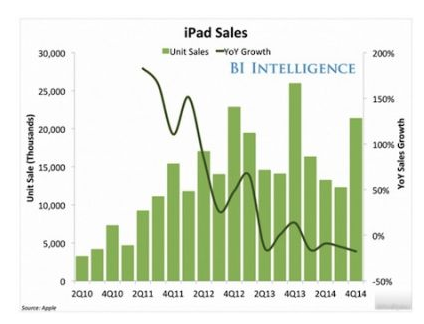 To put it mildly, Wall Street is not happy with tablet sales.
To put it mildly, Wall Street is not happy with tablet sales.
But then there are those “still too small” smartphones!
Hmmmmm! That’s puzzling. What is going on here??
Well, to grossly oversimplify, several factors seem to be at work within these trends:
1) A paucity of tablet apps vis-à-vis the apps available for smartphones! Back in 2010-11 (as tablets were being rolled out) manufacturers promised a plethora of cool, “knock your socks off” apps that leveraged the tablet’s bigger screen. Alas, some promises are just never “delivered upon”… usually because market forces dictate otherwise.
So here we are in 2015, with almost two billion smartphone users versus just a few hundred million users of a tablet! Guess which market gets more attention from app providers?
2) Pound for pound… square inch for square inch… smartphones offer longer battery life. The average battery life of phones has doubled over the past five years… while tablet battery life has (largely) remained stable.[5]
3) Picture quality: I grant that “megapixel” metrics are not the sole determinant of camera quality. However, it does offer a convenient, measurable metric with which to compare cameras. With that caveat offered, consider that top-notch smartphones currently include a 13-megapixel camera, while the average tablet camera offers just 8 megapixels.
4) Web page clarity: have you noticed that, despite a much larger screen size than smartphones… until web site design changes started to be made in expectation of the recent overhaul in Internet search algos … tablets were relegated to somehow trying to make the most of either a much reduced desktop image or a very magnified (and distorted) smartphone image – with neither result being satisfactory.
5) Less productive than the desktop… and not as many functions as are on many smartphones. One can access a wide range of “productivity programs” through the keyboard and screen of a laptop or desktop… and access several of them at a time, as well (ie. multi-task). Alas, most tablets are “one task at a time” devices. [We already identified how/why smartphones offer more apps!]
6) Convergence of size and function: as GOOG’s own (Android) phone has gotten larger, it has (virtually) made the GOOG tablet obsolete. Therefore, with the rollout of the 6” Nexus 6 Smartphone, GOOG announced the discontinuation of its Nexus 7” Tablet!
At this point I should leap in offer reassurance that we need not feel badly for those companies involved in tablet manufacturing and sales!! Yes, tablet growth has started to fall off, but as we’ve seen, there are rather compelling reasons why that is true!!
But tablets losing “share” to smartphones is not an entirely sad development for manufacturers!! The fact is that profit margins on tablet devices have paled in comparison to the profit margins that are commanded by smartphones!! Consider the following:
The Wi-Fi capable Samsung Galaxy 10.1 Tablet is reported to have a manufacturing material cost of $260. Its recommended retail cost has been $500.
In contrast, the Samsung Galaxy S4 Smartphone entails a material cost of $236, but a retail price of $627.
If you are Samsung, which margin do you prefer?[6]
What accounts for the margin difference? Well, of course, there are multiple factors at work. But the easiest factor to identify (and likely biggest) is the now well-entrenched “smartphone subsidy” that cell providers have been lavishing upon new customers when they sign-up for a cell plan “contract”!! That is quite a bargain for phone manufacturers in that it leverages their profit margins upward!![7]
So in which direction(s) will the Computer/Phone market evolve from here?
I cannot offer any special wisdom regarding that question. However, in light of trends evident within current industry data… a reasonable person might consider the following prognostication as “believable”:
1) The fall off in PC sales/popularity may well have plateaued:
According to the International Data Corporation, 4Q 2014 global sales of PCs declined 2.4% year-over-year (YoY)… but that was a significant “beat” compared to an “expected” decline of 4.8%!!
Meanwhile, U.S. PC sales increased by 4.6% YoY during the same period!!
2) Smartphones will continue to evolve and sell well, but with what one might assume will be something of a “ceiling” on screen size. Having already increased screen size from 3.26” (in 2010) to 4.86” (in 2014) (increase of 1.6”) … and knowing the limits of the average human grip… it is hard to imagine that screen size will continue moving upward as fast as it has been moving.
3) What is as plain as the nose on my face[8] is that the impact of Mobile upon virtually every aspect of business (retail and service) will continue to evolve and grow. If one trolls through the Internet, much of this coming mobile evolution has already been projected. For example, as a member of the Baby Boomer generation that witnessed the birth of broadcast TV… and first watched TV on an unbelievably small (9”) black and white screen (with no controls, to boot)…. It astounds me that millions of folks today regularly watch video on a smartphone screen. Excuse me – that’s way too small for me! And yet folks who are much brighter than I am offer have posed this amazing projection:
Therefore, I imagine that Mobile will evolve in many ways that will be surprising… perhaps even in ways that no one has yet anticipated!
4) What might well be changing already is how both smartphones and cellular service are marketed! Hardly anyone I know really likes her/his cell provider. As US News & World Report has expressed it:
“Raise your hand if you hate your cell phone carrier. If your hand is in the air, you’re not alone. From long term contracts to expensive data plans to early termination fees, our cell phones plans and service can be extremely frustrating and costly. A recent [customer service] study ranked customer satisfaction among cell phone carriers with mixed results.“
If you pay attention to ads for cell carriers, you’ll agree that two of the current “hot button” issues for cell users are:
1) Data plan details;
2) Contract costs and termination fees.
Combine those points with a clear trend away from service provider phone subsidies[9] and it is easy to imagine that we will be seeing numerous imaginative ways to re-imagine the way cell service is provided.
Here is a fascinating case in point from giant GOOG itself:
“Project Fi” is a revolutionary wireless service currently being developed. At the moment, it is only available for use on the Nexus 6[10].
However, even if you own a Nexus 6, I must warn you that Fi is strictly an “early access program” – meaning that you cannot use it without an “invitation”, which are issued only a few at a time.[11]
If GOOG is successful in scaling up this “Project”, it will do wonders in shaking up the mammoth wireless industry. Consider the following:
1) Project Fi has not created a new network infrastructure! Instead, it accesses networks that are already in place!
a) Therefore, it acts as a Mobile Virtual Network Operator (MVNO).
b) When a call is placed, the MVNO connects it to the network with the strongest connection… be it WiFi or the LTE network of one of its “partners” (T-Mobile or Sprint).[12]
c) When a transition between WiFi and a cell network is needed and available, GOOG claims that such a transition will be seamless. And if the strongest available connection is a cell network, GOOG promises to detect and connect the call to the fastest network possible, in this descending order of priority: 4G LTE, 3G, 2G.
2) Project Fi allows a user to overlay one’s cell number with any device that supports Google Hangouts.[13]
3) Project Fi also promises not to expect users to pay for data they do not actually use!
a) A “basic plan” is available that provides unlimited domestic talk and text, unlimited international texts, lower cost international calls, and WiFi “tethering”[14]
b) The cost of accessing data anywhere (globally) will be $10 per GB… and if one buys three GB but only uses two GB, the user will be credited for the unused GB on the following month’s bill.
c) On the other hand, if one exceeds her data limit, she will be charged $0.01 for each MB of used data that exceeded her limit.
It will be fascinating to watch how Project Fi does (or doesn’t) shake up the primary existing paradigm for U.S. wireless service.
INVESTOR TAKEAWAY
In the midst of the continuing Mobile Revolution, investment opportunities are as plentiful as the ocean waves rolling in toward a beach. Unfortunately, I don’t have the vision needed to discern “which waves” hold the greatest promise of turning into one that will offer an investor the most exciting “ride” toward portfolio profits!!
For those who feel positively about the diversification advantages of ETFs… there is (ironically) an interesting index (the Dynamic Telecommunications & Wireless Intellidex Index) but the only targeted “wireless” investment vehicle (Merrill Lynch Wireless HOLDRs) was discontinued in 2011 because of a lack of sufficient investor interest!
Of course, there is the Global X Social Media Index ETF (SOCL)… a diversified basket of stocks whose fortunes rise and fall (in large part) due to the success the portfolio companies demonstrate in harnessing the power of “Mobile”. Of special interest in that regard will be the continuing evolution of “Mobile monetization”… an objective that (as we have already described above) has shifted into a different gear now that the watershed moment of Mobile searches exceeding “computer” searches has arrived! It will be interesting to see how the market begins to value different types of “Mobile clicks” – from the “Interstate” example I offered much earlier to the clicks that occur as I wander through the huge Woodfield Mall[15] and my phone is alerted to all the most alluring products and/or menu choices that await me if I merely “click” to see which nearby location eagerly awaits my arrival (and my wallet)!
Finally, you may be particularly intrigued by GOOG’s Project Fi. I understand your interest completely. But please keep in mind that within that the context of giant company ($68 billion annual revenue) the near-term impact of Project Fi on financial metrics and the stock price will be minimal at best.
If on the other hand, your attention is drawn to the two-year long underperformance of GOOG vis-à-vis the S&P 500 Index (the Index has outperformed by over 18%), that is an entirely different matter!
Of course, you should have purchased GOOG on January 12 at $491… that would have netted you a cool 8.75% profit up to this point! But that being “water over the damn”, you could also keep an alert on GOOG and consider entering into a bull put spread with $490 as the short strike if/when GOOG tails back toward that support level during the weeks ahead.
DISCLOSURE:
The author was (obviously) a fan of Get Smart. I wish I had paid closer attention to the visionary insights of Maxwell. It would have gotten me (early) into wireless technology… and now “wearable” technology. The author has, in the past, owned options of GOOG, as well as AAPL, AT&T (T), Verizon Wireless (VZ), etc. His spouse does own VZ and Vodafone (VOD). Nothing in this article is intended as a recommendation to buy or sell anything. Always consult with your financial advisor regarding changes in your portfolio – either subtractions or additions.
FOOTNOTES:
[1] Maxwell Smart is the lead character in a comedy (Get Smart) that aired on network TV between 1965 and 1970 – winning two Global Globe Awards and 21 Emmy Award nominations… seven of which the show won! The show was created by Buck Henry and comic genius Mel Brooks… and starred Don Adams as Maxwell and Barbara Feldon as his sidekick –Agent 99.
[2] OK… I can’t resist one more telling allusion to the technological foresight of Max. Long before GPS was popular and used in fighting crime, this little touch of “mobile tech related” dialogue was aired on GET SMART:
MAX: “The old ‘Call Forwarding From the Shoe phone to the Cell phone so you don't know Where I am and then I appear on the Roof behind you and Surprise everyone’ trick. AGENT 23: [points a gun to Max's temple] “Don't move!”
[3] This “search algo” change is such a big deal, with so many repercussions, that it is being described as “Mobilegeddon”.
[4] Full Disclosure: I only have a modest landlocked home outside of Chicago, IL… and own a broken desktop as well as a 2010 MacBook Pro.
[5] Simple illustration: the 5.5” Galaxy phone offers more than twice the battery life of a Galaxy 7” tablet.
[7] What I mean is that consumers do not “balk” at high smartphone costs when their upfront “net” cash cost is very affordable due to the subsidy.
[8] And folks do say it is quite big
[9] Yes, subsidies are still very significant. However the average % of subsidy vis-a-vis price has been declining.
[10] A phone manufactured by GOOG-owned Motorola.
[11] See the project’s website for more details — https://fi.google.com/about/
[12] While I cannot verify veracity, this is a quote from the website: “Project Fi automatically connects you to more than a million free, open Wi-Fi hotspots we’ve verified as fast and reliable… Your data is secured through encryption when we connect you to open Wi-Fi hotspots. It’s like your data has a private tunnel to drive through [VPN].”
[13] The representation is that through “Hangouts”, a user can make or receive calls (or send/receive text messages) on owner devices such as a desktop, laptop, or tablet.
[14] The cell phone becomes a “hot spot”
[15] In NW Suburban Chicago
Related Posts
Also on Market Tamer…
Follow Us on Facebook

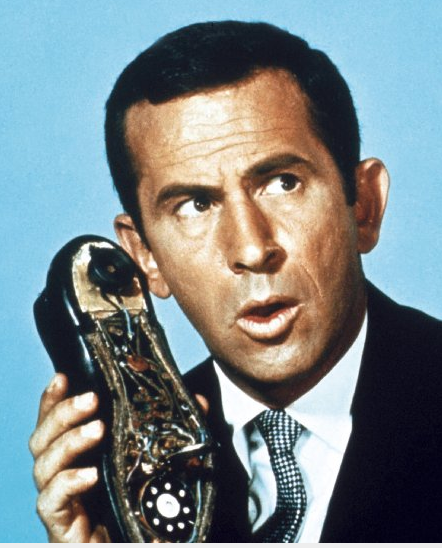
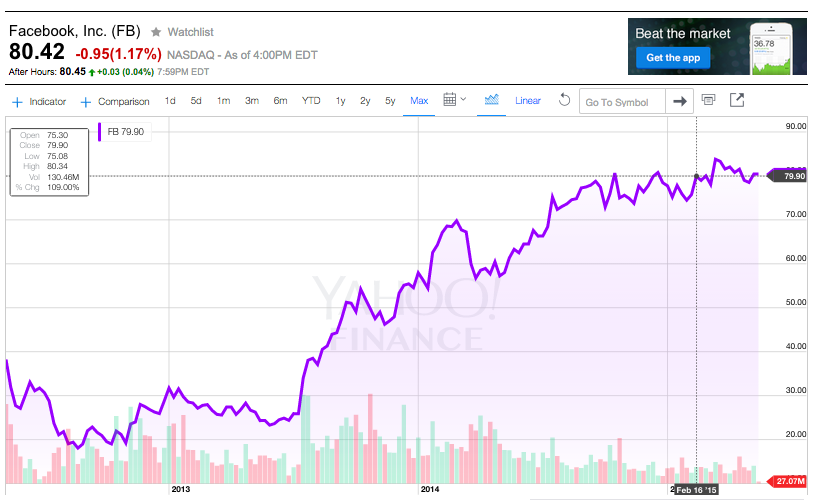

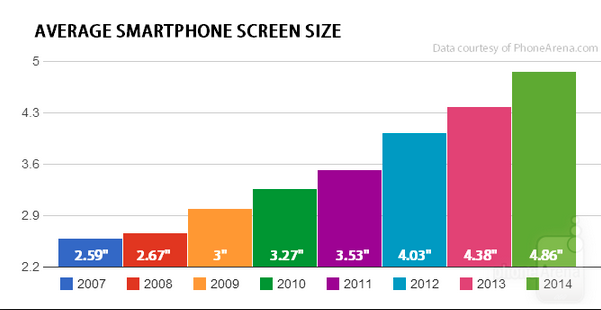
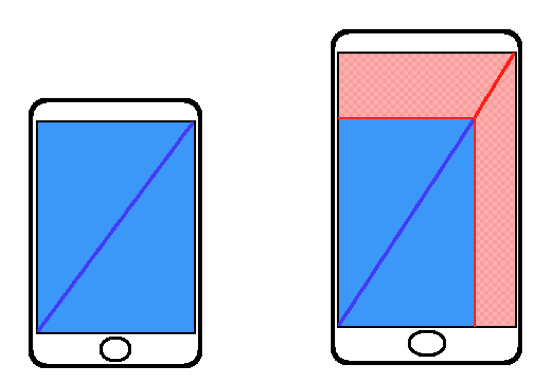
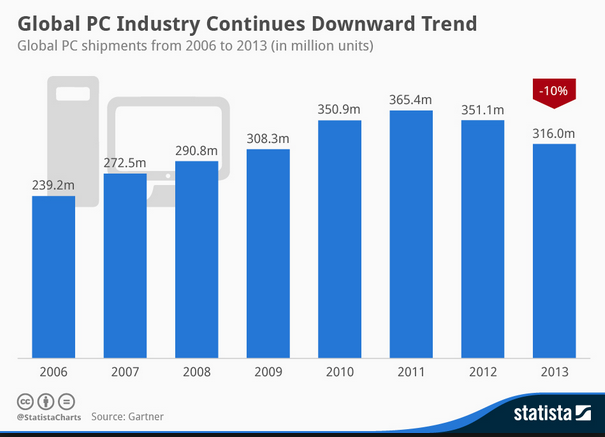
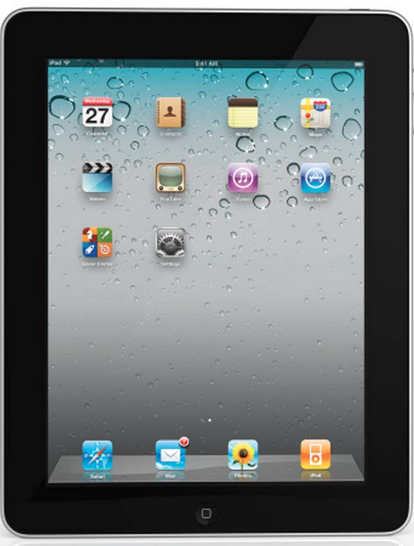
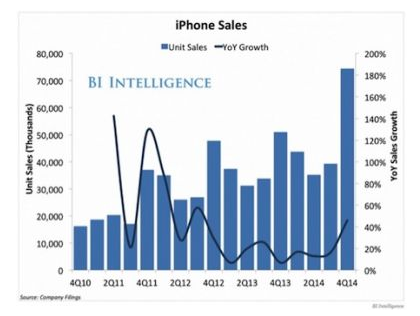
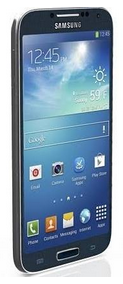
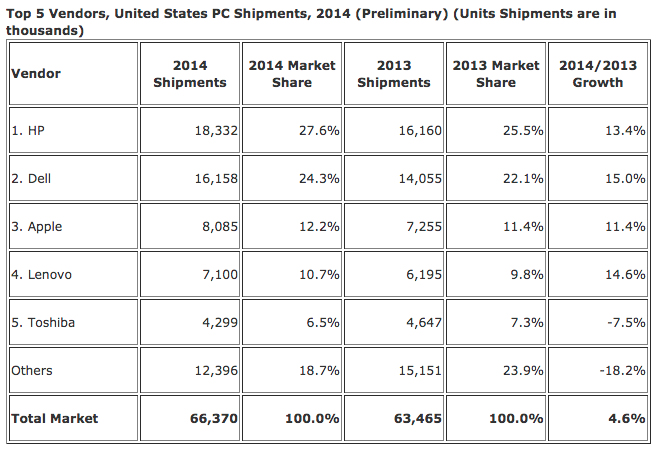
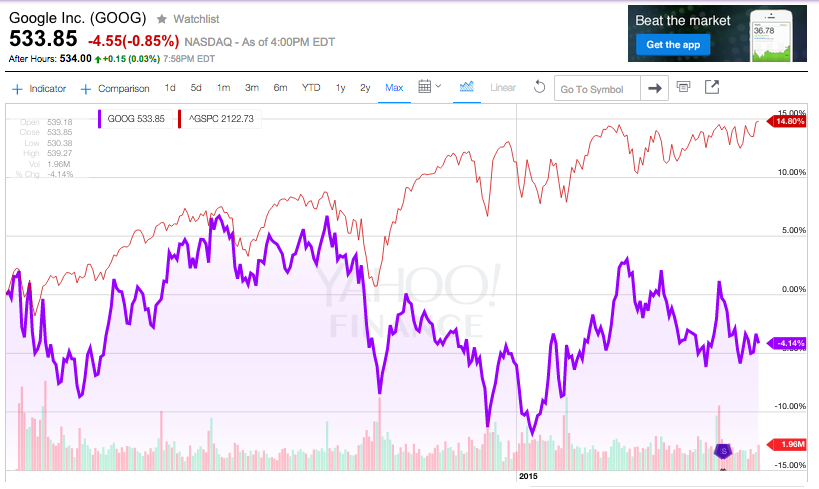
 2 Artificial Intelligence (AI) Chip Stocks to Watch That Aren't Nvidia
2 Artificial Intelligence (AI) Chip Stocks to Watch That Aren't Nvidia

